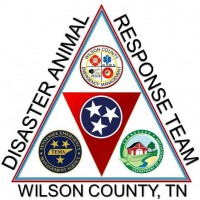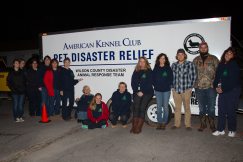Before a Disaster Occurs:
- Keep your pets vaccinations up to date and keep a copy of the paperwork easily accessible. Shelters require proof of vaccines.
- Be sure to have collars with ID tags and rabies tags for each of your pets. Always include your area code on the phone number listed.
- Spay and neuter your pets, so your pet wont get pregnant or impregnate if loose during a disaster.
- Make a list of safe havens for your pet during a disaster. Veterinary Clinics, Pet Friendly Hotels, Shelters, Friends and Relatives already designated.
- Have a friend or neighbor lined up to check on your animals if you are working or away from home when a disaster strikes.
- Keep an emergency kit available at all times and rotate the stock.Keep a two week supply of food and water on hand.
- Every family member should have a role in evacuation. This should be planned and rehearsed ahead of a disaster. Practice loading and evacuating with your animals.
- Place stickers on front and back entry ways, barn doors and pasture entrances to notify emergency personnel that animals are present.
- Have photos of you and your pet together for proof of ownership,in your emergency kit.
During a Disaster:
- Bring your pets inside well in advance and reassure them.
- Never leave a pet chained outdoors.
- Pets are frightened by unfamiliar noises and abnormal weather changes. Keep your pet in sight at all times. Reassure.
- Never tranquilize your pet. It inhibits their natural instincts to survive and escape potential danger.
- Have your emergency kit close at hand. Be ready to shelter in place at home.
After a Disaster:
- Help re-orient your pets by walking them on a leash. They may be confused if landmarks and scents are altered.
- Be on the look out for downed power lines , debris and reptiles brought in with flood waters.
- Do not allow your pet to drink water or eat food that could be contaminated.
- Animals can become aggressive or defensive after a disaster after a disaster. Their Flight or Fight instinct kicks in. Monitor their behavior and notify your vet if this behavior does not subside.
Pet Safety in the Aftermath:
- In the days and weeks after a natural disaster, displaced people and animals face many dangers. Especially when people evacuate expecting to return home in just a few days, going back into a disaster site can present a life threatening situation. Always evacuate with your animals!
- Homes, landmarks, and familiar scents that animals use to find their way home or recognize safe areas can simply vanish in a disaster. This causes disorientation, panic, stress and leads dogs and cats to seek refuge in hazardous situations.
- Flood waters contaminated with waste and bacteria can cause gastroenteritis and intestinal parasites. Most forms of bacteria are transmitted to people and animals resulting in wide spread infections.
- Floating hazards such as building materials, street signs, and tree limbs can cause serious injury to humans and animals.
- Animals trying to swim in flood waters can become quickly exhausted and drown.
- In addition to water supplies, food sources may become contaminated and animals do not understand that they shouldn’t be drink standing water or eat contaminated food.






